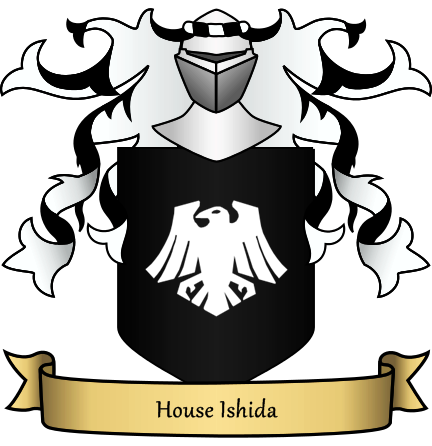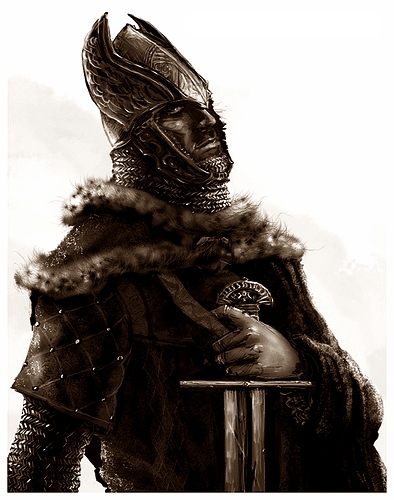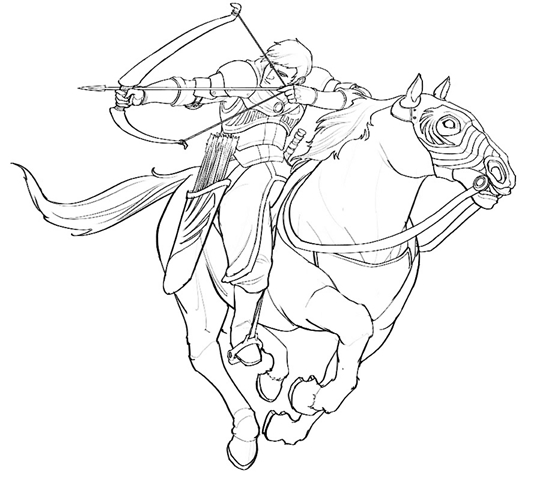Difference between revisions of "Ishida Family"
| Line 4: | Line 4: | ||
| − | The origins of House Ishida are lost to time, but tradition holds that they are descended from a line of Far Eastern nobles who fled from their homeland generations ago. | + | The origins of House Ishida are lost to time, but tradition holds that they are descended from a line of Far Eastern nobles who fled from their homeland generations ago. The main branch of the family has since settled in Atamara. |
| − | |||
| + | === Present Day === | ||
| − | |||
| + | Under the leadership of Mizuhiro the Ishida managed to elevate themselves into the ranks of the peerage. Originally from Sauvia, during the Great Atamaran War Mizuhiro saw fit to relocate the family home and its heirlooms to Craigmore. | ||
| − | + | The Ishida are fair skinned, with characteristically black hair. Though records suggest that their ancestors possessed oriental facial features, the average contemporary Ishida would not look out of place among the high-blooded of Atamara. | |
| Line 29: | Line 29: | ||
The heraldic emblem of House Ishida is a stylised raven with outstretched wings. It is often featured as an argent charge upon a sable field. | The heraldic emblem of House Ishida is a stylised raven with outstretched wings. It is often featured as an argent charge upon a sable field. | ||
| − | The Raven is seen as a creature of cunning and intellect, both qualities prized by the Ishida. The Raven is also a common sight on the battlefield, a reminder to Ishida nobles that one should not fear battle | + | The Raven is seen as a creature of cunning and intellect, both qualities prized by the Ishida. The Raven is also a common sight on the battlefield, a reminder to Ishida nobles that one should not fear battle for there is much opportunity in war. |
| + | |||
| + | The primary colour of House Ishida is a sable, dark as the night. This is found most commonly on the cloaks donned by those who serve the House. | ||
| − | |||
| − | |||
== Residence == | == Residence == | ||
| Line 40: | Line 40: | ||
House Ishida's seat is the '''Ravenholme''', an imposing tower built of smooth black rock. Exceedingly lofty in comparison to the structures around it, the Ravenholme is both a fortification and a residence. Barrack spaces and living quarters have been hewn into the walls of the lower levels, ready to house the Ishida's troops as well as provide guest facilities for visiting nobles. | House Ishida's seat is the '''Ravenholme''', an imposing tower built of smooth black rock. Exceedingly lofty in comparison to the structures around it, the Ravenholme is both a fortification and a residence. Barrack spaces and living quarters have been hewn into the walls of the lower levels, ready to house the Ishida's troops as well as provide guest facilities for visiting nobles. | ||
| − | The Ishida themselves occupy the upper floors | + | The Ishida themselves occupy the upper floors. Compared to the homes of many noble families, the Ravenholme's interiors tend to convey a dark and brooding ambience. Wall-mounted candles provide a measure of light, as many of the lower hallways and rooms have little more than arrow-slits for windows. Furs are a common item, both as decoration and for warmth. |
| + | |||
| + | |||
== The Raven Guard == | == The Raven Guard == | ||
| Line 49: | Line 51: | ||
| − | House Ishida maintains a standing force known as the '''Raven Guard'''. | + | House Ishida maintains a standing force known as the '''Raven Guard'''. The Raven Guard is structured into units known as '''Wings''', each led by a noble commander. |
| Line 56: | Line 58: | ||
| + | In Guard hierarchy, Ishida nobles bear the rank of '''Legate'''. They are the supreme commanders of their Wings as far as the Guard is concerned. | ||
| − | + | Below the nobles are the '''Centurions''', the Guard equivalent of a Captain. Centurions are hand-picked from the ranks for exceptional leadership and courage in battle. | |
| − | + | In times of peace Centurions receive schooling in tactics and philosophy. Such education is costly and difficult to obtain outside of the nobility, and so the rank of Centurion is one that is very much sought after by the common soldiery. | |
| − | + | Wings are often broken down into smaller, squad-sized groupings known as '''Talons'''. A Talon is a squad of 8 to 10 men lead by a '''Decurion''', usually the longest serving man in the Talon. The Decurion's roles are to provide individual leadership to his Talon and to promote camaraderie among his men. | |
| − | |||
| − | === | + | |
| + | === Raven Guard Troops === | ||
| + | |||
| + | |||
| + | ==== First Wing ==== | ||
[[Image: Showcase_09.jpg]] | [[Image: Showcase_09.jpg]] | ||
| Line 72: | Line 78: | ||
| + | The First Wing forms the elite of the Raven Guard and is always designated to the current leader or heir of the House. | ||
| + | |||
| + | They are the cream of the crop; masters of mounted blade-work. Each is armoured with a black composite suit scale and plate, granting commendable protection without sacrificing too much dexterity. Helms and visors hide their faces from view, dehumanising the First Wing to ensure that the enemy sees nothing but death and terror approaching. A hooded cloak of deep crimson (the colour signifying their elite status) completes the outfit, secured with a clasp bearing the insignia of the Raven Guard. | ||
| + | |||
| + | In battle the First Wing rides the charge on barded black destriers. They each wield a pair of matched blades and are taught to use them ambidextrously on horseback. A code of honour binds them to silence while they don their masks, forcing the First Wing to communicate commands in battle via hand gestures. | ||
| − | The First Wing | + | The Centurion of the First Wing is referred to instead as '''Huntmaster''' (or '''Huntmistress''' if female) in recognition of the extreme proficiency required of the individual who manages to acquire this position. |
| − | |||
| − | |||
| − | + | ==== Linesmen ==== | |
| − | |||
| + | Linesmen make up the majority of the Guard's rank-and-file. The average Linesman is equipped with a round shield, axe or (more rarely) short sword, and several javelins. They are usually armoured in leather and/or chainmail, depending on the resources available to their Legate. | ||
| + | In battle the Linesmen are called to do exactly as their name suggests; hold the line. Discipline and cohesion are core tenets of the Linesmen cohorts, and reckless bravery is touted as foolish in the face of organised formations. Linesmen tactics commonly involve forming a shield wall with the front ranks while their comrades in the rear fling javelins to whittle down the enemy. | ||
| − | |||
| + | ==== Shieldbearers ==== | ||
| − | |||
| − | + | The Shieldbearers are a corps of men who disdain ranged warfare, preferring instead to rely on stoutness of body and heart to weather all threats. Their trademarks are the large shields that they carry into battle, capable of covering a man from chin to shin. Usually armoured in chainmail or better, the cumbersome nature of their attire leads most Shieldbearers to opt for a mace or hand axe in battle, instead of a sword. | |
| − | + | Shieldbearer cohorts are known for their doggedness and skill in utilising the box formation. They take much pride in forming a "fortress" of armoured men, a stout barrier of wood and steel to bolster weak spots in the battle line. | |
| − | + | ||
| − | + | ==== The Ravensworn ==== | |
| − | |||
[[File:Ravensworn.jpeg]] | [[File:Ravensworn.jpeg]] | ||
| − | + | There are many in the Guard who aspire to serve in the First Wing, not a difficult thing to understand given the associated benefits that come from being an elite force. Naturally, applicants must undertake a stringent training regime and succeed in a number of tests before they can be counted among the best of the Guard. | |
| + | |||
| + | Many fail at some point or other, and those who wish to submit their names for another try are allowed to do so on one condition; they must serve for two years with the Ravensworn. | ||
| − | + | The Ravensworn operate as a tactically flexible light cavalry force, trained primarily for extended sorties and scouting missions, but also to act as mounted skirmishers in battle when needed. More lightly armoured than the First Wing, they are equipped with swords and short bows to take advantage of their greater mobility. | |
| − | + | As failed applicants seeking reconsideration the Ravensworn are usually called upon for demanding military assignments far from home. These men ride into battles with fervour, hoping to distinguish themselves in the eyes of their superiors. | |
| − | |||
| − | |||
== Notable Members == | == Notable Members == | ||
Revision as of 16:58, 20 March 2013
Contents
House Ishida
Origins
The origins of House Ishida are lost to time, but tradition holds that they are descended from a line of Far Eastern nobles who fled from their homeland generations ago. The main branch of the family has since settled in Atamara.
Present Day
Under the leadership of Mizuhiro the Ishida managed to elevate themselves into the ranks of the peerage. Originally from Sauvia, during the Great Atamaran War Mizuhiro saw fit to relocate the family home and its heirlooms to Craigmore.
The Ishida are fair skinned, with characteristically black hair. Though records suggest that their ancestors possessed oriental facial features, the average contemporary Ishida would not look out of place among the high-blooded of Atamara.
Heraldry
Heraldic device of House Ishida
The heraldic emblem of House Ishida is a stylised raven with outstretched wings. It is often featured as an argent charge upon a sable field.
The Raven is seen as a creature of cunning and intellect, both qualities prized by the Ishida. The Raven is also a common sight on the battlefield, a reminder to Ishida nobles that one should not fear battle for there is much opportunity in war.
The primary colour of House Ishida is a sable, dark as the night. This is found most commonly on the cloaks donned by those who serve the House.
Residence
House Ishida's seat is the Ravenholme, an imposing tower built of smooth black rock. Exceedingly lofty in comparison to the structures around it, the Ravenholme is both a fortification and a residence. Barrack spaces and living quarters have been hewn into the walls of the lower levels, ready to house the Ishida's troops as well as provide guest facilities for visiting nobles.
The Ishida themselves occupy the upper floors. Compared to the homes of many noble families, the Ravenholme's interiors tend to convey a dark and brooding ambience. Wall-mounted candles provide a measure of light, as many of the lower hallways and rooms have little more than arrow-slits for windows. Furs are a common item, both as decoration and for warmth.
The Raven Guard
A Centurion of the Raven Guard
House Ishida maintains a standing force known as the Raven Guard. The Raven Guard is structured into units known as Wings, each led by a noble commander.
Raven Guard Hierarchy
In Guard hierarchy, Ishida nobles bear the rank of Legate. They are the supreme commanders of their Wings as far as the Guard is concerned.
Below the nobles are the Centurions, the Guard equivalent of a Captain. Centurions are hand-picked from the ranks for exceptional leadership and courage in battle.
In times of peace Centurions receive schooling in tactics and philosophy. Such education is costly and difficult to obtain outside of the nobility, and so the rank of Centurion is one that is very much sought after by the common soldiery.
Wings are often broken down into smaller, squad-sized groupings known as Talons. A Talon is a squad of 8 to 10 men lead by a Decurion, usually the longest serving man in the Talon. The Decurion's roles are to provide individual leadership to his Talon and to promote camaraderie among his men.
Raven Guard Troops
First Wing
The Horsemen of the First
The First Wing forms the elite of the Raven Guard and is always designated to the current leader or heir of the House.
They are the cream of the crop; masters of mounted blade-work. Each is armoured with a black composite suit scale and plate, granting commendable protection without sacrificing too much dexterity. Helms and visors hide their faces from view, dehumanising the First Wing to ensure that the enemy sees nothing but death and terror approaching. A hooded cloak of deep crimson (the colour signifying their elite status) completes the outfit, secured with a clasp bearing the insignia of the Raven Guard.
In battle the First Wing rides the charge on barded black destriers. They each wield a pair of matched blades and are taught to use them ambidextrously on horseback. A code of honour binds them to silence while they don their masks, forcing the First Wing to communicate commands in battle via hand gestures.
The Centurion of the First Wing is referred to instead as Huntmaster (or Huntmistress if female) in recognition of the extreme proficiency required of the individual who manages to acquire this position.
Linesmen
Linesmen make up the majority of the Guard's rank-and-file. The average Linesman is equipped with a round shield, axe or (more rarely) short sword, and several javelins. They are usually armoured in leather and/or chainmail, depending on the resources available to their Legate.
In battle the Linesmen are called to do exactly as their name suggests; hold the line. Discipline and cohesion are core tenets of the Linesmen cohorts, and reckless bravery is touted as foolish in the face of organised formations. Linesmen tactics commonly involve forming a shield wall with the front ranks while their comrades in the rear fling javelins to whittle down the enemy.
Shieldbearers
The Shieldbearers are a corps of men who disdain ranged warfare, preferring instead to rely on stoutness of body and heart to weather all threats. Their trademarks are the large shields that they carry into battle, capable of covering a man from chin to shin. Usually armoured in chainmail or better, the cumbersome nature of their attire leads most Shieldbearers to opt for a mace or hand axe in battle, instead of a sword.
Shieldbearer cohorts are known for their doggedness and skill in utilising the box formation. They take much pride in forming a "fortress" of armoured men, a stout barrier of wood and steel to bolster weak spots in the battle line.
The Ravensworn
There are many in the Guard who aspire to serve in the First Wing, not a difficult thing to understand given the associated benefits that come from being an elite force. Naturally, applicants must undertake a stringent training regime and succeed in a number of tests before they can be counted among the best of the Guard.
Many fail at some point or other, and those who wish to submit their names for another try are allowed to do so on one condition; they must serve for two years with the Ravensworn.
The Ravensworn operate as a tactically flexible light cavalry force, trained primarily for extended sorties and scouting missions, but also to act as mounted skirmishers in battle when needed. More lightly armoured than the First Wing, they are equipped with swords and short bows to take advantage of their greater mobility.
As failed applicants seeking reconsideration the Ravensworn are usually called upon for demanding military assignments far from home. These men ride into battles with fervour, hoping to distinguish themselves in the eyes of their superiors.
Notable Members
- Mizuhiro Ishida, Atamara, Cagilan Empire
- Tetsuko Ishida, Atamara, Talerium (Hiatus)
- Himeko Ishida, Dwilight, Corsanctum
- Isamu Ishida, Atamara, Cagilan Empire



